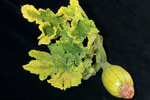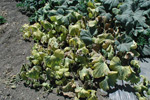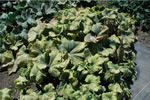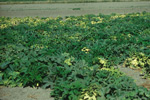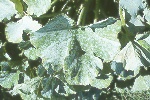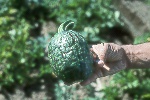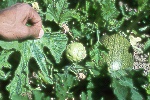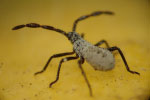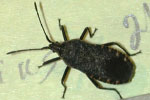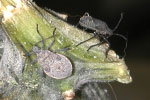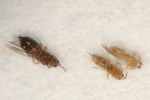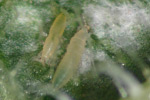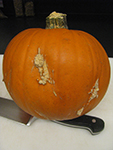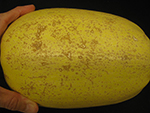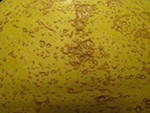Photo Gallery of Vegetable Problems
Pumpkin
(Click on photo to enlarge)
Diseases
Disease: Curly top
Pathogen: Various strains of Beet curly top virus (BCTV), which are vectored by the beet leafhopper (Circulifer tenellus)
Host crops: Numerous plant species including many vegetables such as bean, beet, carrot, eggplant, coriander, pepper, potato, tomato, various cucurbits such as squash, cucumber, pumpkin, watermelon, etc.
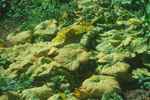 |
|
| Symptoms of curly top in a squash crop. | |
| Photo Source: Phil Ham, OSU plant pathologist | |
On-Line Resources:
Pacific Northwest Plant Disease Management Handbook: Squash (Cucurbita spp.) – Curly Top
Disease: Powdery mildew
Pathogen: Golovinomyces cichoracearum (formerly Erysiphe cichoracearum) and Podosphaera fuliginea (formerly Sphaerotheca fuliginea)
Host crops: All cucurbit vegetables (e.g. cucumber, cantaloupe, melon, pumpkin, and squash). There are different races of the pathogens.
On-Line Resources:
Cucumber, Pumpkin, Squash: Powdery Mildew, Washington State University Hortsense
Disease: Root Rot
Pathogen: Pythium
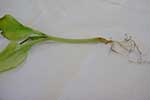 |
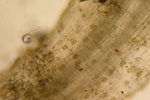 |
|
| Pumpkin seedling. | Microscopic view of roots with round, thick-walled oospores of Pythium embedded in the root tissues. | |
| Photo Source: Jenny Glass | ||
On-Line Resources: Pacific Northwest Plant Disease Management Handbook: Watermelon (Citrullus lanatus) – Damping-off
Pacific Northwest Plant Disease Management Handbook: Cucumber (Cucumis sativus) – Damping-off
Disease: Suspected zucchini yellows + watermelon mosaic virus
Pathogen:
On-Line Resources:
Disease: Suspected virus
Pathogen: Unknown
On-Line Resources:
Disease: Verticillium wilt
Pathogen: Verticillium species
Host crops: Numerous vegetables including many brassica vegetables (but not broccoli), cucumber, eggplant, pepper, potato, pumpkin, radish, spinach, tomato, watermelon, etc.
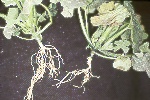 |
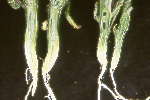 |
| Pumpkin ‘We-Be-Little’ | |
| Photo Source: D.A. Inglis | |
On-Line Resources:
Cucumber, Pumpkin, Squash: Verticillium wilt, Washington State University Hortsense
See Diseases, pests, and other problems common to many vegetables: Verticillium wilt.
Insect/Mite Pests
Common name: Bean aphid, green peach aphid, melon aphid, and potato aphid
Latin binomial: Aphis fabae , Myzus persicae, Aphis gossypii, and Macrosiphum euphorbiae respectively
Host crops: In addition to tomato, eggplant and pepper, bean, melon, sweet corn, corn seed, carrot, cucumber, and eggplant the bean aphid can feed on spinach, Swiss chard, squash, pumpkin, and beet. The green peach aphid can feed on potato, tomato, eggplant, pepper, broccoli, cabbage, spinach, Swiss chard, squash, pumpkin, beet and many weed species including Brassicaceae (cruciferous) weeds. The melon aphid can feed on cucumber, melon, pumpkin, squash, spinach and spinach seed. The potato aphid can feed on cucumber, potato, melon, tomato, pumpkins, squash, and corn seed.
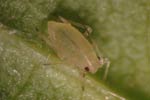 |
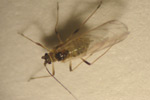 |
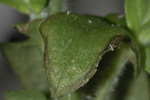 |
| Green peach aphid may be found along the midrib on the underside of leaves of a host plant. Mature aphids are about 2 mm long (ca. 1/16 inch), egg-shaped, and the color of the wingless nymphs and adults ranges from pinkish yellow to yellowish green. There are usually multiple individuals in a single colony. | The green peach aphid tends to overwinter in stone fruit trees. By late May to early June, individual aphids in a colony develop wings and fly to vegetable crops and a wide range of weeds. As the aphids disperse (June to August), they can transmit important viruses including potato leaf roll virus and potato virus Y. | The easiest way to scout for aphid colonies is to search perimeter vegetable plants for copious amounts of sticky, glistening honeydew coating the upper surfaces of lower leaves of plants. Honeydew may contain numerous cast (shed) skins (white to gray) and a black sooty mold (fungus) that colonizes aphid honeydew. |
| Photo Source: Michael Bush, WSU Extension, Yakima, WA | ||
On-Line Resources:
Pacific Northwest Insect Management Handbook: Vegetable crop pests-Aphid
Pacific Northwest Insect Management Handbook: Pumpkin and squash – Aphid
Common Insect & Mite: Aphids, Washington State University Hortsense
See Diseases, pests, and other problems common to many vegetables: Aphids
For aphids on other crops see: potato, and squash
Common name: Squash bug
Latin binomial: Anasa tristis
Host crops: Cucurbit vegetables (e.g. pumpkin and squash).
On-Line Resources:
Pacific Northwest Insect Management Handbook. Chapter: Vegetables, Section: Pumpkin and Squash, pt.2.
Vegetables: Cucumber, Pumpkin, Squash: Squash bug.. Washington State University Hortsense.
See See Diseases, pests, and other problems common to many vegetables: Squash bug.
Common name: Western flower thrips
Latin binomial: Frankliniella occidentalis.
Host crops: Basil, Broccoli, Cabbage, Cauliflower, Cucumber, Onion, Potato, Pumpkin, Squash, Tomato and Watermelon.
On-Line Resources:
Western Flower Thrips Thysanoptera: Thripidae Frankiniella occidentalis,
Cucurbits: Thrips, UC IPM Online, University of California
See Diseases, pests, and other problems common to many vegetables: Western flower thrips.
Abiotic Problems
Problem: Edema
A physiological problem: prominent when air is cooler than the soil, soil moisture is high, and relative humidity is high. The low plant transpiration rates combined with an increase in water absorption by roots from the soil leads to increased cell turgor pressure, resulting in eruption of epidermal cells as the inner cells enlarge. Protrusion of the inner cells causes epidermal cells to die and discolor, resulting in a ’warty’ appearance that can be misidentified as a disease. In addition to foliar symptoms on some hosts, many cucurbit crops develop wart-like protruberances on the fruit.
On-Line Resources:
https://www.omafra.gov.on.ca/english/crops/facts/00-031.htm#oedema
Our pages provide links to external sites for the convenience of users. WSU Extension does not manage these external sites, nor does Extension review, control, or take responsibility for the content of these sites. These external sites do not implicitly or explicitly represent official positions and policies of WSU Extension.

